Breaking Barriers to Healthcare Access
In today’s rapidly evolving healthcare landscape, virtual care has emerged as a vital resource, especially for uninsured populations seeking affordable, convenient, and comprehensive medical services. With the proliferation of telehealth platforms offering transparent pricing and broad service options, uninsured individuals can now access quality healthcare without the burdens of traditional insurance models. This article explores the array of affordable virtual care solutions available, their benefits, and how they are transforming healthcare accessibility for those most in need.
Overview of Affordable Virtual Healthcare Options

What are some affordable virtual healthcare options available for uninsured patients?
Uninsured patients seeking convenient and budget-friendly medical care can turn to several virtual healthcare providers that offer transparent, upfront pricing. These services are designed to deliver quality care without the complications of insurance or surprise bills.
Teladoc Health is one of the leading names in this space, offering services such as urgent care, mental health, dermatology reviews, and nutrition support at fixed rates—typically around $89 to $119 per visit. Patients can select a self-pay option easily, without needing insurance coverage, making healthcare accessible and straightforward.
MinuteClinic Virtual Care™ provides 24/7 video consultations with licensed healthcare providers. Services include diagnosis and treatment of common illnesses like colds, flu, COVID-19, and minor infections, with out-of-pocket costs ranging from $59 to $129. This platform emphasizes quick access, often connecting patients to a provider within minutes.
Doctor On Demand features 24/7 virtual visits for urgent care and mental health support. Many sessions can be as low as $0 if covered by insurance or employer benefits; otherwise, the fixed fee for uninsured individuals is around $99 for a medical consultation. The platform accepts most insurance plans and provides clear cost estimates before appointments.
Platforms like Sesame also cater to uninsured patients by offering hassle-free, affordable urgent care services through video appointments. They operate in all 50 states and D.C., providing treatment for conditions such as infections, skin issues, allergies, and migraines. There are no membership fees, and prescriptions are prescribed when appropriate.
Walgreens Virtual Healthcare offers online visits with doctors and nurse practitioners specifically for non-emergency conditions. Prices range from $33 to $79, and patients can pay using credit or debit cards, without the need for insurance. Services include treatment for a wide range of issues like infections, women’s health, and lab testing requests.
These virtual care options are widespread across the U.S., making it easier than ever for uninsured individuals to access quick, affordable healthcare from the comfort of their home.
Benefits of Virtual Care for Uninsured Populations
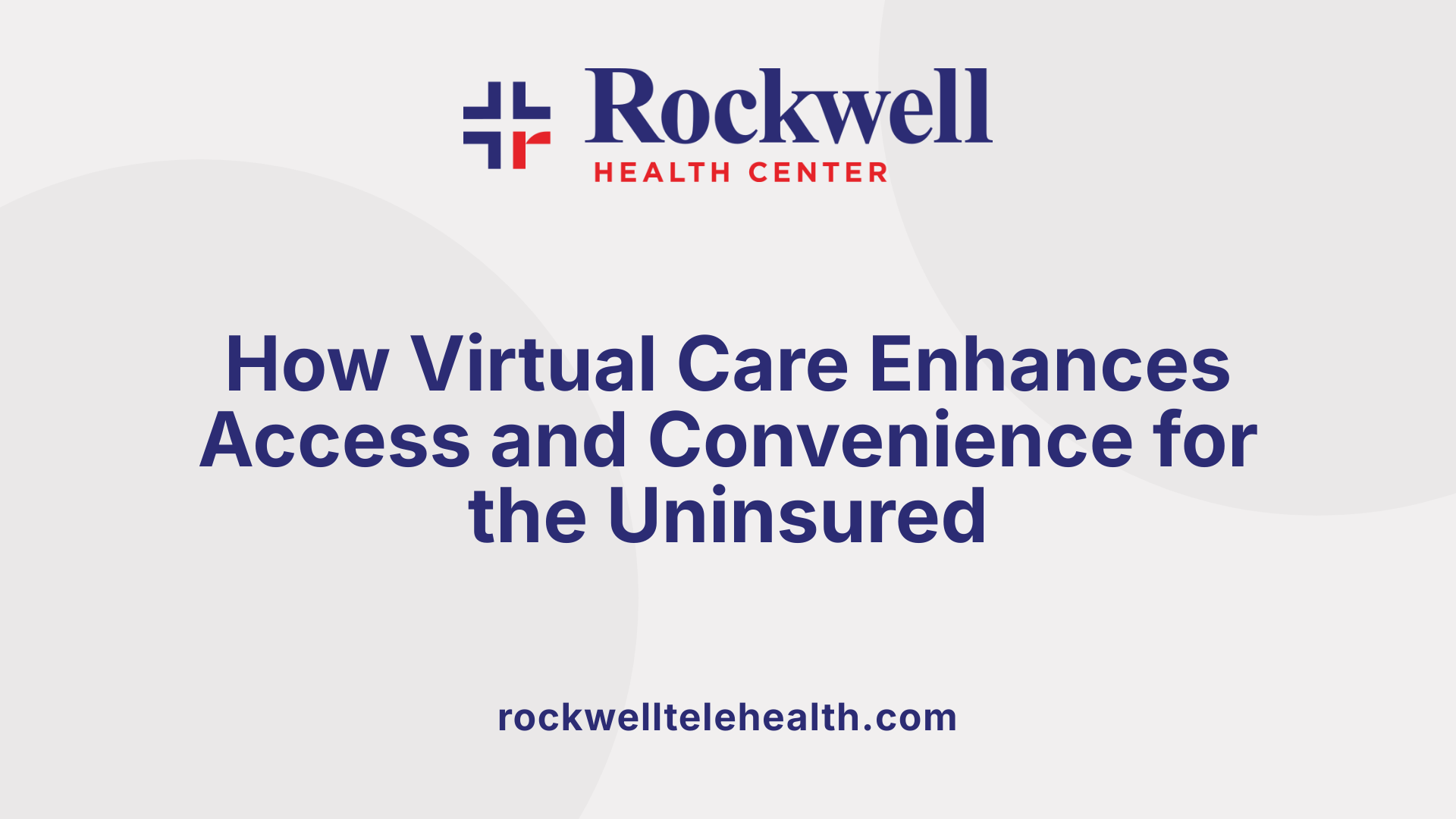
How does virtual care improve access and convenience for those without insurance?
Virtual healthcare platforms like Teladoc, Doctor On Demand, Sesame, and Walgreens Virtual Healthcare make it easier for uninsured individuals to receive medical attention without leaving home. Patients can access services 24/7 via websites or apps, often within minutes, and avoid long waits typical of in-person clinics.
Many services are tailored specifically for those who pay out of pocket, with transparent flat rates such as $89 for urgent care and dermatology or $119 for mental health consultations. Some platforms, like Doctor On Demand, offer low-cost or even free visits depending on eligibility, making healthcare more reachable regardless of insurance status.
This ease of access ensures that more people can seek timely treatment for common illnesses, mental health concerns, and chronic conditions, especially in remote or underserved areas.
What are the cost benefits of virtual care for uninsured individuals?
Cost savings stand out as one of the main advantages. Virtual providers often charge set prices that are significantly lower than in-person services or emergency room visits. For example, virtual urgent care visits might cost between $33 to $119, depending on the service.
Uninsured patients avoid expenses such as travel, waiting room fees, and additional charges linked to in-person visits. Furthermore, many platforms accept various payment methods, including credit cards and health savings accounts, simplifying payment processes.
By reducing out-of-pocket costs, virtual care helps more uninsured people afford essential medical attention without the financial burden.
How does virtual care support management of chronic and mental health conditions?
Many virtual healthcare providers offer ongoing support for chronic illnesses and mental health issues through subscriptions, scheduled therapy sessions, and medication management.
BetterHelp, for instance, provides mental health support via a subscription model, offering continuous therapy access but without medication support. Similarly, platforms like Cigna and Doctor On Demand enable patients to connect with therapists, psychiatrists, and primary care providers for diagnoses, treatment plans, and medication prescriptions when appropriate.
Access to consistent care from home fosters better disease management, reduces hospitalizations, and improves overall well-being, especially for those who might otherwise lack local healthcare options.
In what ways does virtual care enhance public health and disease control?
Virtual healthcare plays a crucial role in controlling infectious diseases by decreasing the need for in-person visits, which can be risky during outbreaks like COVID-19. Many services target non-emergency conditions such as colds, flu, and other infections, helping to reduce transmission.
Platforms also enable timely screening, testing, and follow-up, which contribute to early detection and containment of illnesses. As they are available round the clock, individuals can seek advice and treatment promptly, helping to prevent disease spread.
Furthermore, virtual care supports public health efforts by enabling easier contact tracing and monitoring, essential during pandemic situations. This approach promotes healthier communities by making healthcare accessible, affordable, and safer for all, especially those without insurance.
Available Telehealth Services Without Insurance
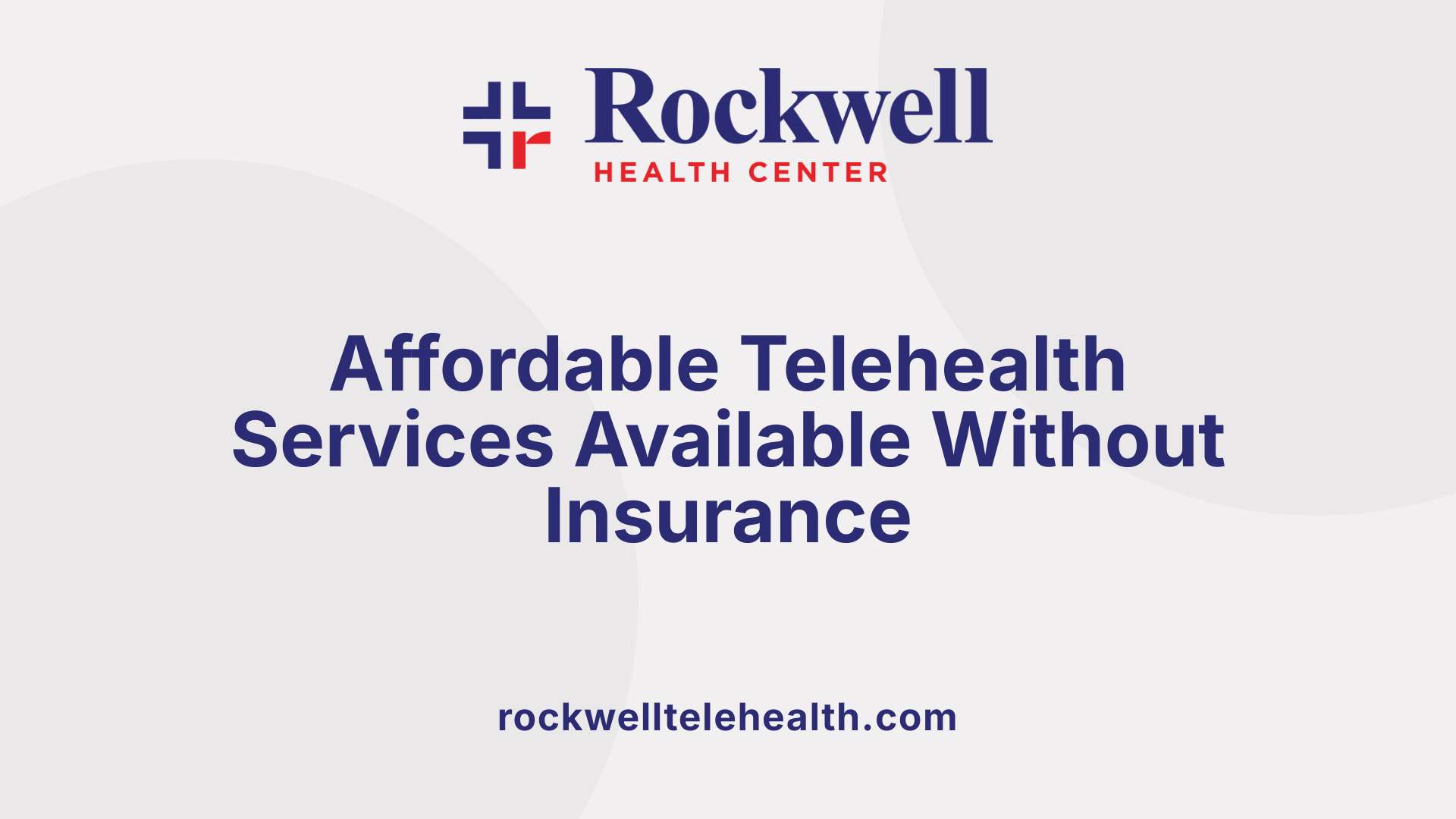 Many telehealth platforms now offer accessible care options without requiring insurance. These services provide affordable virtual consultations for a wide range of health concerns, often with transparent upfront pricing.
Many telehealth platforms now offer accessible care options without requiring insurance. These services provide affordable virtual consultations for a wide range of health concerns, often with transparent upfront pricing.
For instance, Teladoc Health caters to uninsured patients through various self-pay options. Patients can access urgent care, dermatology reviews, nutrition counseling, and mental health services, all for set prices like $89 for urgent care or $119 for mental health consultations. These prices are straightforward, enabling patients to understand costs before seeking care.
Similarly, Doctor On Demand provides 24/7 access to urgent care, mental health, and primary care services, with many visits starting as low as $99 without insurance. Sesame offers 24/7 virtual urgent care across all 50 states and DC, with no membership fees and charges ranging from $59 to $109 depending on the service. Walgreens Virtual Healthcare offers visits from $33 to $79 in select states, covering nonemergency conditions like infections, women's health, and allergies.
These platforms prioritize quick access, often starting appointments within minutes. They also allow patients to get prescriptions when appropriate, though controlled substances are generally not prescribed.
Range of Conditions Treated
- Common illnesses like cold, flu, COVID-19, and infections
- Skin issues, allergies, migraines
- UTI, sore throat, STIs
- Mental health concerns such as anxiety and depression
- Chronic condition management
Service Accessibility and Features
- No insurance needed; pay out-of-pocket
- Transparent prices with upfront quotes
- Available 24/7, including holidays
- Easy online scheduling via website or app
- Multiple payment options, including credit/debit, HSA, and FSA cards
- Prescriptions sent directly to pharmacies
These services make healthcare more reachable for those without insurance, cutting wait times and reducing costs. They are ideal for non-emergency conditions requiring prompt attention, providing an effective, affordable solution for uninsured Americans.
Access Points and Utilizing Virtual Healthcare
How can uninsured patients access virtual healthcare services?
Uninsured individuals have multiple ways to access virtual healthcare, making medical support more affordable and reachable. They can use online telehealth platforms and telemedicine apps that require only an internet connection and basic registration. These platforms offer convenience, privacy, and quick connections to healthcare providers.
Some popular options include services like Teladoc Health, Doctor On Demand, Sesame, Walgreens Virtual Healthcare, and virtual care offered through insurance providers like Cigna. Many of these platforms allow uninsured patients to select self-pay options with transparent upfront costs, often ranging from $33 to $119 for various services. For example, Sesame provides urgent care with no membership fees or hidden bills, while Walgreens offers visits for as low as $33.
Patients can typically access these services via mobile apps or web portals. They are often able to get timely diagnoses, treatment plans, and prescriptions when needed. For mental health support, platforms like BetterHelp and Mental health services through Doctor On Demand offer subscription-based or pay-per-visit options.
It’s also beneficial to explore community programs and public health initiatives, which sometimes partner with telehealth providers to offer free or reduced-cost services. Overall, uninsured patients should research local and national telehealth options, verify platform security (HIPAA compliance), and compare costs to find the best solution for their needs.
Cost Structures and Pricing Strategies
What are the typical cost structures and pricing for virtual care solutions aimed at uninsured individuals?
Many virtual care providers focus on making healthcare accessible and affordable for individuals without insurance. They often adopt a variety of pricing options to suit different patient needs.
One common approach is offering transparent, flat-rate fees for specific services. For example, patients can pay a set price like $89 for urgent care, dermatology reviews, or nutrition counseling. These upfront costs provide clarity, so patients know exactly what they will pay before the appointment.
Another popular model is pay-per-visit pricing, where patients are charged only for the consultation they receive. For instance, services like Sesame or Walgreens Virtual Healthcare offer consultations costing between $33 and $79, with no insurance needed and payment made directly via credit, debit, or HSA/FSA cards.
Some providers also implement sliding-scale fees based on income, helping low-income individuals access necessary care at reduced costs. This flexibility aims to eliminate financial barriers and promote healthcare equity.
Overall, these strategies focus on affordability and transparency, ensuring uninsured patients can obtain timely medical attention without facing surprise bills or high costs.
| Pricing Model | Typical Cost Range | Additional Details |
|---|---|---|
| Flat-rate fee | $89–$119 | Set price for specific services like urgent care or mental health |
| Pay-per-visit | $33–$89 | Charges only for the consultations used |
| Subscription-based | Varies | Monthly plans for ongoing mental health support (e.g., BetterHelp) |
| Sliding-scale | Reduced fees | Based on income, for low-income populations |
These flexible pricing options are vital in making virtual healthcare accessible for those without insurance, delivering quality care at a cost they can afford.
Budget-Friendly Virtual Healthcare Providers
How do virtual care solutions offer budget-friendly options?
Virtual healthcare providers have made it easier for patients to access affordable medical services. They often use different pricing models, such as pay-per-visit or flat fees, to keep costs predictable and low.
Many platforms, including MinuteClinic Virtual Care and Walgreens Virtual Healthcare, set transparent prices for common medical issues. Typically, these fees range from $29 to $129, making them cheaper than visiting a doctor in person.
Some services accept most insurance plans, including Medicaid and Medicare, which lowers out-of-pocket expenses for insured patients. Others, like Sesame and GoodRx Care, focus on helping those without insurance by offering low-cost or flat-rate virtual visits.
Additionally, providers sometimes offer discounts or sliding-scale fees based on income, making healthcare accessible for uninsured and low-income individuals.
Thanks to lower overhead costs and flexible payment options—credit cards, HSA or FSA accounts—these platforms deliver affordable care to a wide group of patients.
| Provider Name | Typical Cost Range | Payment Methods Accepted | Special Features |
|---|---|---|---|
| MinuteClinic Virtual Care | $59 - $119 | Most insurance, credit, FSA, HSA | 24/7 availability, common illness treatment |
| Walgreens Virtual Healthcare | $33 - $79 | Credit, debit, HSA/FSA | Immediate start, lab testing access |
| Sesame | No membership fees, standard affordable prices | Credit, debit, FSA, HSA | No surprise bills, available nationwide |
| Doctor On Demand | Many visits as low as $0 with benefits | Most insurance, credit | Wide range of services including mental health |
This approach ensures that more people, including the uninsured, can access necessary healthcare without breaking the bank.
Types of Conditions Treatable via Affordable Telehealth
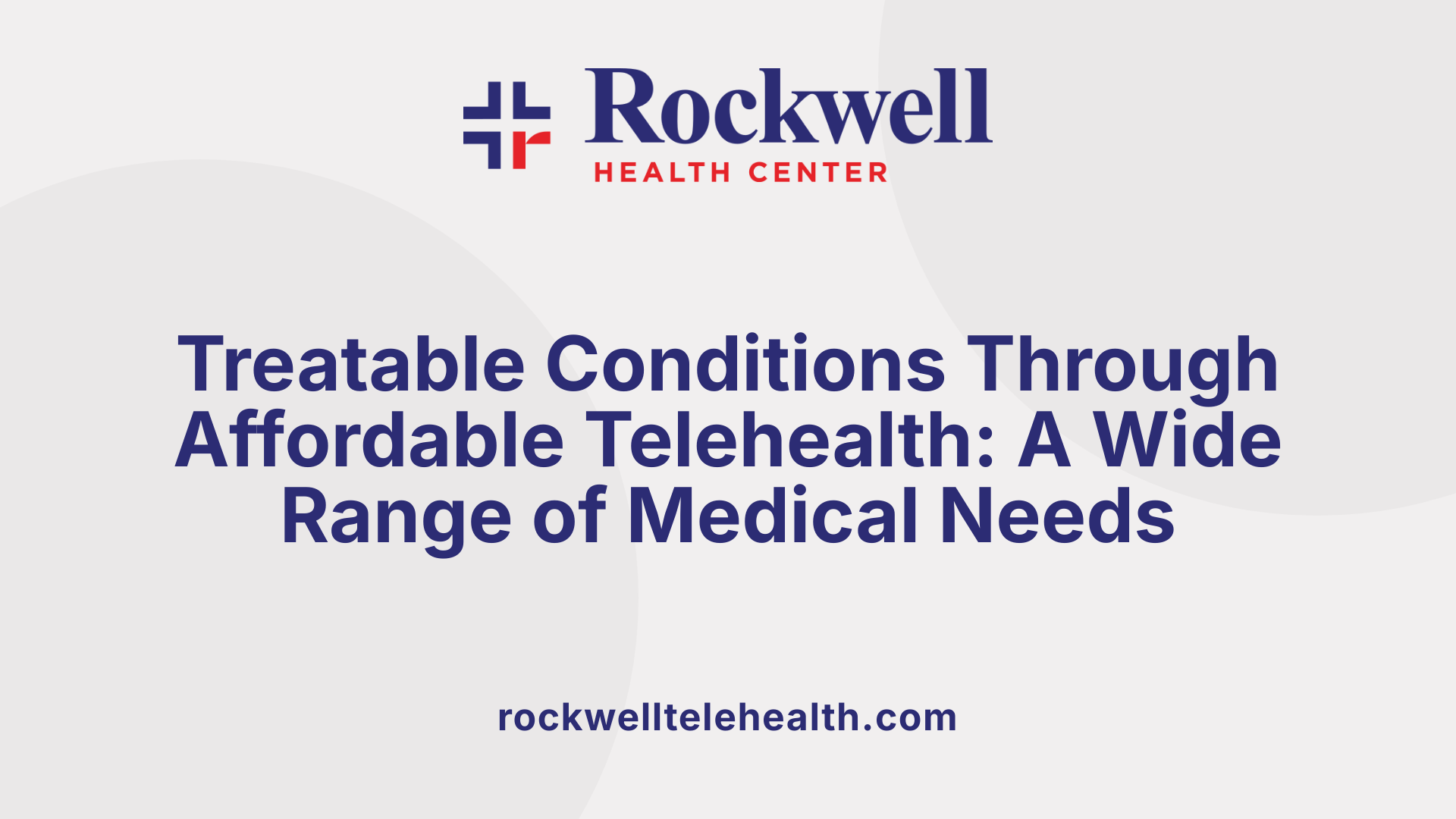
What types of health issues can be treated through affordable telehealth services?
Affordable telehealth platforms like Teladoc, Doctor On Demand, Sesame, Walgreens Virtual Healthcare, and Cigna provide accessible healthcare for a variety of non-emergency conditions. These services can effectively address common illnesses such as colds, the flu, COVID-19, sore throats, skin infections, allergies, migraines, and sexually transmitted infections (STIs). Patients with minor injuries or those needing follow-up care after treatments also benefit from virtual visits.
Chronic disease management is another prominent feature. Conditions like diabetes, hypertension, thyroid disorders, and allergy symptoms can be monitored and managed remotely, helping patients maintain their health without frequent in-person visits.
Mental health is a significant focus for many telehealth providers. Issues such as anxiety, depression, stress, postpartum challenges, PTSD, and other psychological concerns can be addressed through therapy sessions or psychiatric medication management, although medication support may vary.
In addition, virtual care supports treatment for minor injuries, provides follow-up consultations, and enables remote monitoring of vital signs like blood pressure and blood sugar levels. This flexibility ensures that patients receive timely care, reducing unnecessary trips to clinics or emergency rooms.
Overall, these telehealth services enhance healthcare accessibility, affordability, and convenience, especially for ongoing or non-urgent medical needs across various medical specialties.
Supporting Uninsured Patients Beyond Traditional Models

How do virtual care solutions support uninsured patients outside of traditional insurance models?
Virtual care options are transforming healthcare access for uninsured individuals by providing affordable, flexible, and immediate services. Many platforms, such as Teladoc Health, Doctor On Demand, Sesame, Walgreens Virtual Healthcare, and Cigna, offer pay-per-visit models that do not require insurance coverage. For example, patients can access urgent care or mental health consultations for as low as $29 to $119 per visit, often with transparent upfront costs.
These services operate around the clock, including holidays, enabling patients to seek care whenever needed without waiting for in-person appointments. They cover common ailments like colds, flu, infections, skin conditions, and mental health issues such as anxiety or depression. Some platforms also facilitate prescription issuance to local pharmacies, making medication management more straightforward.
Beyond individual consultations, virtual care often accepts various payment methods, including credit cards, debit cards, and Health Savings Account (HSA) or Flexible Spending Account (FSA) funds, reducing financial barriers. Many services, such as Healthlink JAX, go further by offering free virtual visits, outreach programs, and connecting uninsured populations with local resources.
This approach not only lowers costs but also enhances accessibility—especially for those in rural or underserved areas—by providing quick, remote access to healthcare providers. As a result, virtual care expands the reach of healthcare services, supports ongoing health management, and ensures uninsured patients receive necessary care outside of traditional insurance channels.
Embracing Virtual Healthcare for a Healthier Future
As virtual healthcare continues to evolve, its role in bridging the gap for uninsured patients becomes increasingly vital. The combination of transparent pricing, broad service offerings, and expandability into mental health and chronic disease management makes telehealth a practical solution for improving health outcomes. By leveraging these innovative platforms, uninsured populations can enjoy more equitable access to healthcare, ultimately promoting a healthier, more inclusive society. Embracing virtual care is not just a convenience but a necessary step towards ensuring that no one is left behind in the pursuit of good health.
References
- Affordable Virtual Healthcare Without Insurance
- MinuteClinic Virtual Care
- Doctor On Demand® Telehealth: 24-Hour Online Doctor
- Online Urgent Care: 24/7 Telehealth, No Insurance Needed
- Walgreens Virtual Healthcare: Online Doctor & Prescriptions
- Virtual Care (Telehealth) Services
- Amazon One Medical | Telehealth & In-Person Visits
- Doctor On Demand® Telehealth: 24-Hour Online Doctor
- Healthlink JAX




















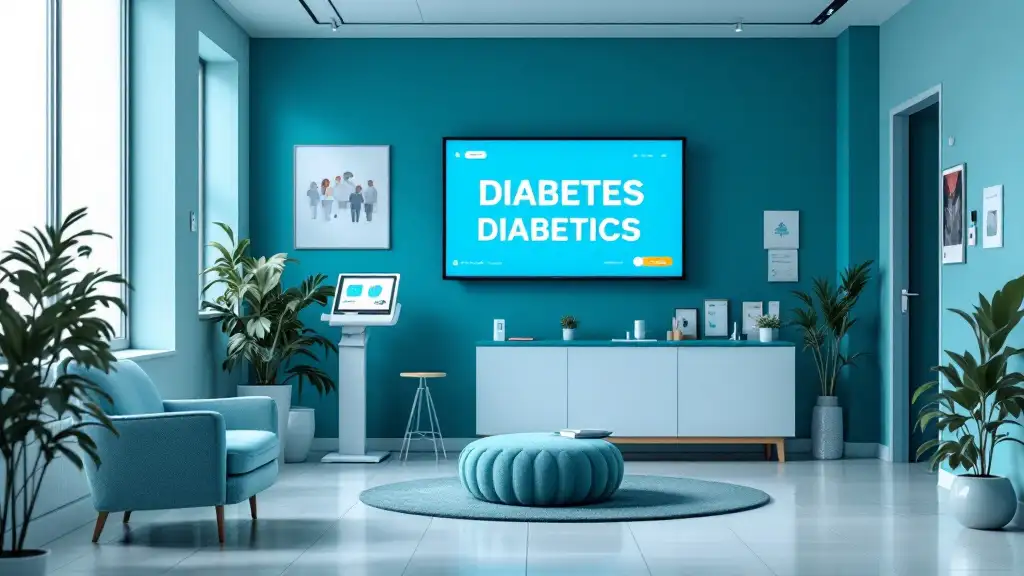
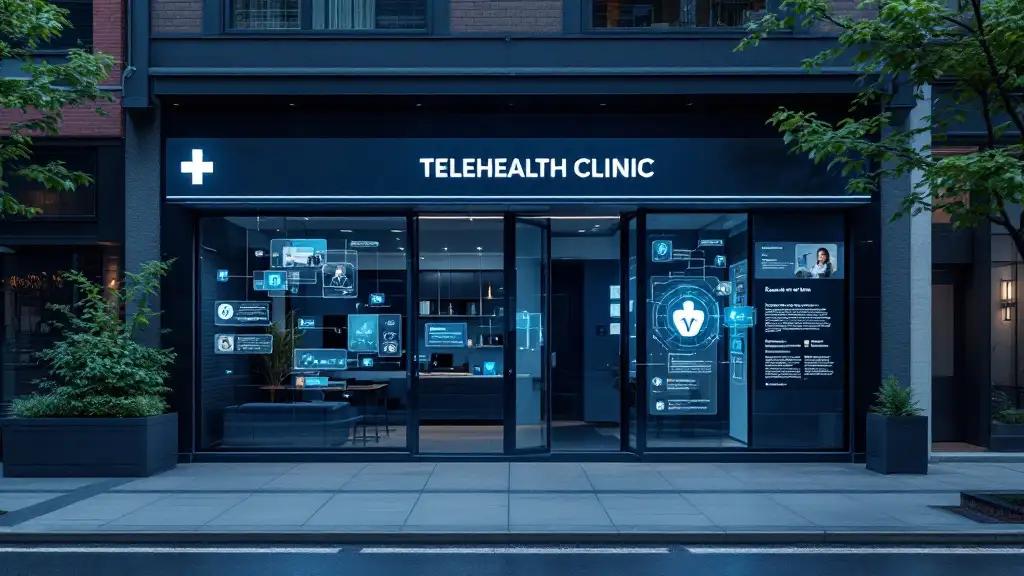


































































.png)